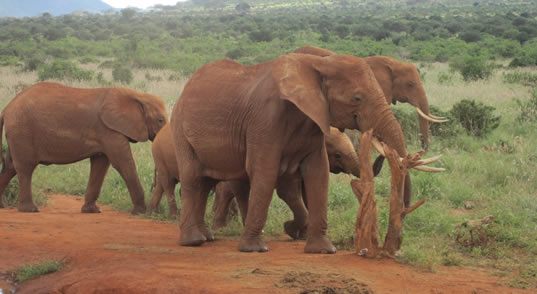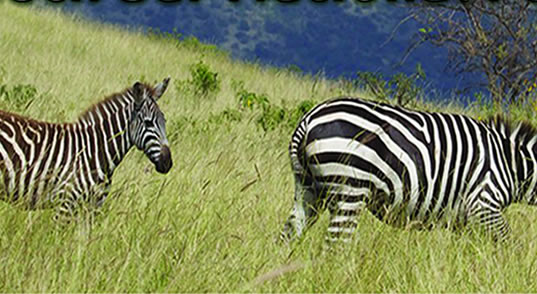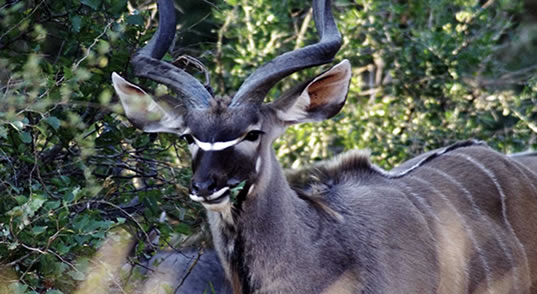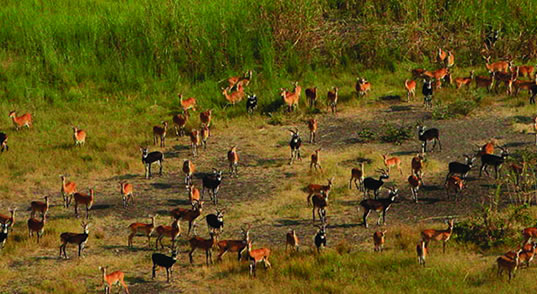

- Awash National Park
- Omo National Park
- Bale Mountain National Park
- Simien Mountains National Park
- Chebra-Curchura National Park
- Nech Sar National Park
- Mago National Park
- Maze National Park
- Gambela National Park
- Kafta Sheraro National Park
- The Danakil Depression
- Blue Nile Falls and Bahirdar

Awash National Park lies 225 kilometers east of the capital, Addis Ababa and is believed to be the oldest and most developed wildlife reserve in Ethiopia. The park covers 827 square kilometers featuring Fantalle Volcano (1,800 meter), extensive mineral hot-springs and other extraordinary volcanic formations. The park is crossed by the deep cutting path of the River Awash, a river with neither source nor outlet. The wildlife consists mainly of East African plain animals including Minilik’s Bushbuck, Hippopotamus, Beisa Oryx, bat-eared fox, klipspringer, caracal, leopard, aardvark, colobus and green monkeys, Anubis and Hamadryas baboons, Soemmering's gazelle, cheetah, lion and kudu. In addition, the park is a habitat for about 462 species of birds of these, six are endemic namely Banded Barbet, Goldon-Nacked Woodpecker, White-Winged Cliff Chat, White-Tailed Starling, thick-billed raven and Wattle Ibis.

Far to the south-west, the Omo National Park, the largest in the country, with an area of 4,068 square kilometers is located. This vast expanse of true wilderness, adjacent to the Omo River, is one of the richest andleast-visited wildlife sanctuaries in eastern Africa. Eland, Oryx, Burchell's zebra, Lelwel hartebeest, buffalo, giraffe, elephant, waterbuck, kudu, lion, leopard, Anubis Baboon, cheetah and many other animals roam within the park's boundaries. In addition, the Omo NP is a habitat for over 306 colorful birds specious including Goliath herons, blue-breasted kingfishers, white-cheeked turacos, emerald-spotted wood doves and red-fronted bee-eaters. Beyond the open gallery forest on the Coast of Omo River, hippos graze on the savannah slopes against the mountain walls, and waterbuck, bushbuck and Abyssinian ground hornbills are sometimes to be seen.The area is also a wonderful destination to visit local peoples and their cultures like Surma, Muri, Dizi.

The Bale Mountains National Park is located 400 km southeast of Addis Ababa. It was established in 1970, this park covers about 2,200 square kilometers of the Bale Mountains and it belongs to the Bale-Arsi massif, which forms the western section of the south - eastern Ethiopian highlands. The park is the largest area of Afro-alpine habitat in the whole of the continent. It is a home for various flora and wildlife species. The park which comprises reverie plains, woodlands and bush land, is a home for several endemic species like Mountain Nyala and Semien Fox, where the park is believed to be established to protect these two animals. Bale Mountains National Park is home to high mountains and covers the largest area above 3000mt. above sea level in Africa. Tullu Dimtuu, altitude of 4377m above sea level, is the highest peak in the park and the second highest peak in Ethiopia. A large proportion of the Bale Mountains fauna is endemic- found nowhere else in the world, and in some cases nowhere else in Ethiopia. The variety of species and high rate of endemicity is due to the wide variety of habitats conserved in Bale Mountains NP and to the isolation of the highland areas of Ethiopia from other similar highlands in Eastern Africa, by the surrounding hot dry lands. The forest is a home for different species like lions, leopards, spotted hyenas, African hunting dogs and many others. More over the Bale Mountains are home for 16 endemic bird species.The park is among the most suitable walking areas in the country with a chance to see several endemic and common species at a closer distance. The three main sub-sections of the park, Northern Gaysay area, Central peaks and Sannetti plateau area and Southern Harenna area are demarcated by altitude, and this also controls vegetation zonation. Thus the central peaks and plateau area consists of Afroalpine vegetation; the northern Gaysay area of grassland, swamp and woodlands; and the southern Harenna area of dense forest.

Simien Mountains the Landscape of lash grassland, seep Gorges, plunging waterfalls, Spectacular rocky peaks, home to rear specious. The beautiful Simien mountain National Park lays nearly 100kms from the city of Gondar to the northeast direction. 40 million years of Massive erosion of the Ethiopian plateau has created one of the most spectacular landscapes in the world, Simien Mountains. The park was established in 1969 to protect the rear specious of Walia Ibex, a type of wild goat.It’s a must see destination for wildlife, scenery and botanical tours. The simien mountain massif is one of the major highlands of Africa, rising to the highest point in Ethiopia, Ras Dejen (4620m), which is the fourth highest peak in the continent. The Park was one of the first four sites to be inscribed on the World Heritage List in 1978. The Park is the refuge of the extremely rare Ethiopian wolf, gelada baboon (the blooding heat monkey) and Walia ibex, which is unique not only to Ethiopia but unique to the Simien’s. The national park has three general botanical regions having mountain grasslands with fescue grasses as well as heathers, splendid Red Hot Pokers and Giant Lobelia. Over 50 species of birds have been reported in the Simien Mountains.

This park is one of the relatively untouched, recently discovered and rich wilderness areasin Ethiopia. Chebra-Curchurais unique & highly attractive national park which is characterized by highly heterogeneous landscapes having hilly terrain, flat lands and rolling plains with incised river and perennial streams, valley and gorges. The Park is fortunate in possessing numerous rivers, streams and small creator lakes (Keriballa, Shasho, Koka) which are reason for the rich wildlife resources of the area. Zigina River is rises from the north east highlands of the area and cross the central part of the park(north to south) and feeds the Omo River. Shoshuma River is rises from the northwestern highlands of the Konta area highlands cross the northeastern part of the park and mixed with Zigina River inside the park, which go down together to Omo River. So far, 37 larger mammals and 237 species of birds have been recorded in the different habitats of the park. White-cliff chat, banded-barbet, Wattled ibis, black-headed forest Oriole and thick billed raven are endemic birds for the company common mammals include the African Elephant, hippopotamus, Cape Buffalo, Lion, and leopard. Currently, Chebra-CurchuraNP appears to be the least disturbed and reliable ecosystem for the African elephant and Buffalo in the country. The Park & surrounding area also has different natural and cultural attractions such as different hot and cold springs, lakes and caves.

Nechsar National Park was established in 1974 with the aim of conserving the endemic Swayne's Hartebeest and preserving its scenic beauty. It is situated 510 km south of Addis Ababa near the town of Arba Minch. It is bounded by the Amaro Mountains in the east, north by Lake Abaya, and south by Lake Chamo. The park is a home of over 104 mammals, 351 specious of birds and a wide variety of vascular plants. The park is known for its diversity of habitats ranging from savannah, dry bush and ground water forests which is a shelter for different mammals including the endemic Swayne’s Hartebeest, Greater Kudu, Burchett Zebra, Minilik’s Bushbuck, Jackal, Waterbuck, Guenther’s Did-Dik, Lion, Leopard, Spotted Hyena, Cheetah, Velvet Monkey, Olive Monkey, Honey Badger, Anubis Baboon and Caracel. The lakes support stocks of Nile perch and cat Fish. Lake Chamo has another beauty for the park with its Giant Nile Crocodile population. It is the only site in the world to seen this unique Crocodile specious. The "crocodile market" located on the Northwestern shores of Lakes Chamo and Hot springs found in the eastern part of the park are an added attraction.

It lies on the eastern sides of a small branch of the eastern Rift Valley (Omo depression) located 800 km southwest of and Addis Ababa.The Park is fortunate in possessing numerous rivers and streams, which are by far reasons for the rich wildlife resources of the area. Mago River rises from the northeast highlands of the area and cross the park (north to south) and feeds the Omo River. Omo, Mago, and Neri rivers are typical features for the Mago National Park. The Park supports a typical bush savanna fauna with 81 larger mammals & 237 species of bird. Among mammals: African Elephant, Buffalo, Lesser Kudu, Greater Kudu, Duiker, Warthog, Tiang, Lewel’s Hartebeests, Oryx, grant’s Gazelle, Gerenuk, Giraffe, Cheetah, Wild Dog, Lions, Leopards, Gureza - Colobus, Common Baboon and Verevt Monkey are common & conspicuous. The Park area is also very well-known for its rich cultural diversity, where many elements of the earliest nomadic lifestyles are still continued. Hammer, Benna, Mursi, Ngagatom, Ari, Karo, Body, Kwegu are communities very well known for their traditional culture, lifestyles, colorful body decoration, ceremonies, festivals, rituals, and other living expressions.

Maze National Park was established in 2005 G.C.It is 210 square kilometers wide & it is 490 kilometers away from Addis Ababa.The fauna of the Maze National Park supports a wide range of savannah species. So far 39 larger and medium sized mammals and 196 birds’ species have been recorded. The landscape is breathtaking and important for sustainable eco-tourism development. It is one of the three sites in the world where good population of the endemic Swayne’s Hartebeest’s population still survive. Besides, orbi, Bohor red buck, buffalo, warthog, bushbuck, waterbuck, greater kudu, lesser kudu, bush pig, Anubus baboon, vervet monkey, lion, leopard, wild cats, serval cat are among others common species. The Mago National Park and the surrounding area have also different natural, cultural and historical attractions such as Bilbo Hot Springs and Wenja Stone Cave.

The Baro River area, accessible by land or air through the western Ethiopian town of Gambela, remains a place of adventure and challenge. Traveling across the endless undulating plains of high Sudanese grass, visitors can enjoy a sense of achievement in just finding their way. This is Ethiopia's true tropical zone and here you can found all the elements of the African safari, enhanced by a distinctly Ethiopian flavor. Nile perch weighing 100 kilos can be caught in the waters of the Baro, snatched from the jaws of the huge crocodiles that thrive along the riverbank. The White-eared Kob also haunts the Baro, along with other riverbank residents that include the Nile Lechwe, Buffalo, Giraffe, Tiang, Waterbuck, Roan Antelope, Zebra, Bushbuck, Abyssinian Reedbuck, Warthog, Hartebeest, Lion, Elephant and Hippopotamus.

Kafta Sheraro National Park is a newly found national park in Northern Ethiopia. A total of 167 mammal species, 95 bird species and 9 reptile species have been recorded at the site.The park is home to a trans-boundary African elephant population of about 100 - 150 individuals, which it shares with Eritrea's Gash-Setit. It a place where large concentration of Demoiselle Cranes in recorded in Ethiopia /Eritrea. It appears to confirm that the Kafta-Sheraro area serves as a wintering site for the species, and identifies this part of the Tekeze Valley as a wetland of international significance. Other notable wildlife species include Lion, Leopard, Caracal, Aardvark, Greater Kudu, Roan Antelope, Red-fronted Gazelle and Red-Necked ostrich.

The Danakil Depression, in the northeastern corner of Ethiopia, is one of the lowest places on earth, with altitude of 116mt below sea level. It stretches from the foothills of the eastern slopes of Ethiopian Plateau to the Red sea. It’s fully inhabited by the nomadic people of Afar. Danakil is the home of Erta Ale Volcano, one of only 4 living lava lakes in the world and the colorful pillars of salt and hot springs at Dallol. The other amazing attractions of the Danakil are its camel caravans, which carry salt through the desert up to Ethiopian Highlands and Lake Assal, a salt lake, where the Afar come to mine salt, and where some beautiful photo ops are created when the salt is covered with water.

Bahirdar is a town set on the south - eastern shore of lake Tana, where local fishermen still use papyrus boats, and just 30 km from the spectacular Blue Nile/ Tis isat Falls. Here the Blue Nile creates “Smoking Water" an awe-inspiring sight as it plunges into the gorge below.
From Bahirdar one must explore some of the ancient monasteries that have been built around Lake Tana, or on the many Islands. The colorful local market at Bahirdar is renowned for its weavers and woodworkers.
Lake Tana, the largest lake, in Ethiopia is the source and from where the famed Blue Nile starts its long journey to Khartoum, and on to the Mediterranean. The 37 islands that are scattered about the surface of the Lake shelter fascinating churches and monasteries, some of which have histories dating back to the 13th Century. However, it should be noted that most of the religious houses are not open to women. The most interesting islands are: Birgida Mariam, Dega Estefanous, Narga, Tana Cherkos, Mitsele Fasiledes, Kebran and Debre Mariam.


